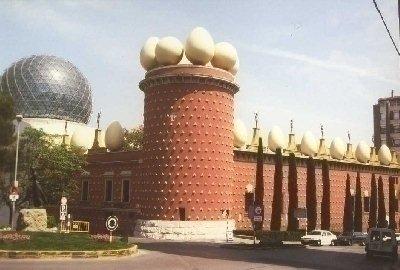| Figueres - Dalí Museum | |
|
|
|
|
1/2 Day or 1 Day |
|
|
Dalí
Theatre and Museum The
Dalí Theatre and Museum (Teatre-Museu Dalí in Catalan language), is a
museum of the artist Salvador Dalí in his home town of Figueres, in
Catalonia. The
heart of the museum was the building that housed the town's theatre when
Dalí was a child, and where one of the first public exhibitions of young
Dalí's art was shown. The old theater was bombed in the Spanish Civil War
and remained in a state of ruin for decades until Dalí and the mayor of
Figueres decided to rebuild it as a museum dedicated to the town's most
famous son in 1960. The museum also occupies buildings and courtyards
adjacent to the old theater building. The
museum opened in 1974, with continuing expansions through the mid-1980s.
It houses the single largest and most diverse collection of works by
Salvador Dalí, the heart of which was from the artist's own collection.
In addition to Dalí paintings from all decades of his career, there are
Dalí sculptures, 3-dimensional collages, mechanical devices, a living-room
with custom furniture that looks like the face of Mae West when viewed
from a certain spot, and other curiosities from Dalí's imagination. The
museum also houses a small selection of works by other artists collected
by Dalí, ranging from El Greco to Marcel Duchamp, and a gallery devoted
to the work of Dalí's friend and fellow Catalan artist Antoni Pitxot, who
became director of the museum after Dalí's death. Dalí
is buried in a crypt in the Teatre-Museum basement. Come
and visit Europe's biggest fortress Come
and see Sant Ferran Castle, the biggest fortress in Europe towering
majestically over the town of Figueres. Sant
Ferran Castle surveys from its watchtower the centuries of history it has
been through since Ferdinand VI ordered it to be built in 1751. To get
there, take the Pujada del Castell road and leave your car parked on the
open area you'll find before getting to the first guard posts. You
will soon see that it's an impregnable construction standing in a
privileged spot. It was in fact the arrival of French troops in the second
half of the seventeenth century and the beginning of the eighteenth that
made it necessary to have military facilities at that border location. Go
into the castle through the monumental gateway and then walk around the
3.2 kilometers of walls enclosing the fortification's 32.5 hectares of
space inside. If you have time and an interest in knowing the full history
of the place, ask for an audio-guide at the entrance: if you follow what
it says, you will be able to discover every corner of the fortress, step
by step. You'll
be taken aback by the splendor of the parade ground before going into the
fortresses' buildings, which were still used for military purposes until a
few years ago. Standing on the walls at their highest point, you will see
the 5 km of ditches surrounding the castle; and deep inside it you'll find
the tanks, which can hold up to nine million litres of water. Indeed all
the figures are stunning when examining this, one of the world's largest
fortified strongholds. The castle can accommodate a garrison of 6,000 men and 500 horses, and in its day it was regarded as a model of military architecture. Nowadays the soldiers have been replaced by visitors, enjoying the chance to explore all the striking features of a fortress whose characteristics make it unique. |
|
